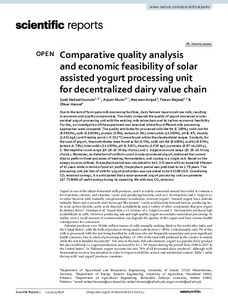| dcterms.abstract | Due to the lack of farm-gate milk processing facilities, dairy farmers have to sell raw milk, resulting in economic and quality compromises. The study compared the quality of yogurt processed in solar assisted yogurt processing unit with the existing milk value chain and its techno-economic feasibility. For this, an investigation of the experiment was executed where four different milk processing approaches were compared. The quality attributes for processed milk like fat (5.283%), solid-not-fat (9.0833%), salts (0.6833%), protein (3.8%), lactose (4.1%), total solids (14.383%), pH (6.87), density (1.031 kg/L) and freezing point (− 0.532 °C) were found within the standardized ranges. Similarly, for the case of yogurt, these attributes were found as fat (5.5%), solid-not-fat (8.683%), acidity (0.93%), lactose (4.73%), total solids (14.183%), pH (4.3433), density (1.039 kg/L) syneresis (9.87 mL/100 g), S. thermophilus count range (10.18–10.30 log cfu/mL) and L. bulgaricus count range (10.26–10.34 log cfu/mL). Moreover, no detection of coliform count in solar-processed yogurt, endorsed the current idea to perform three processes of heating, fermentation, and cooling in a single unit. Based on the energy sources utilized, the payback period was calculated to be 1.3–9 years with an expected lifespan of 15 years while in terms of product profit, the payback period was predicted to be 1.78 years. The processing cost per liter of milk for yogurt production was calculated to be 0.0189 USD. Considering CO₂ emission savings, it is anticipated that a solar-powered yogurt processing unit can generate 107.73 MWh of useful energy during its operating life with zero CO₂ emission. | eng |


